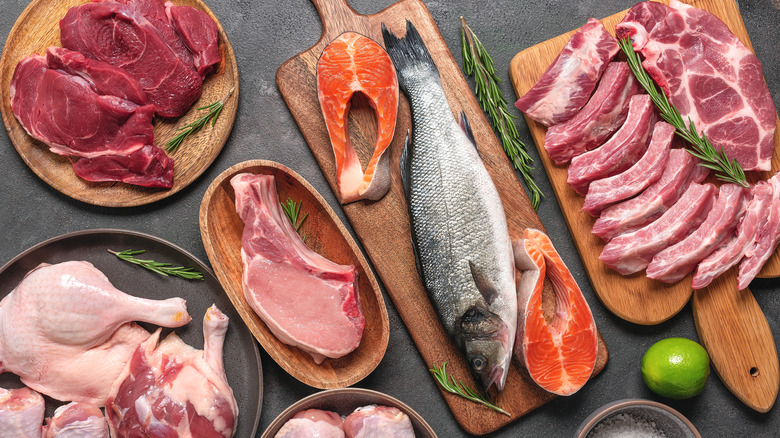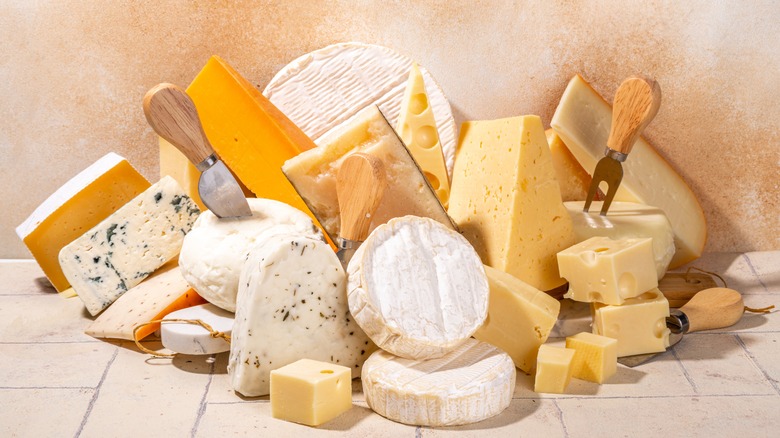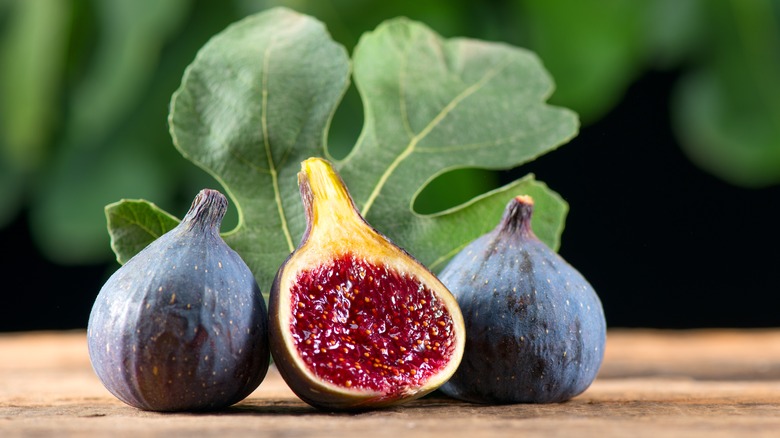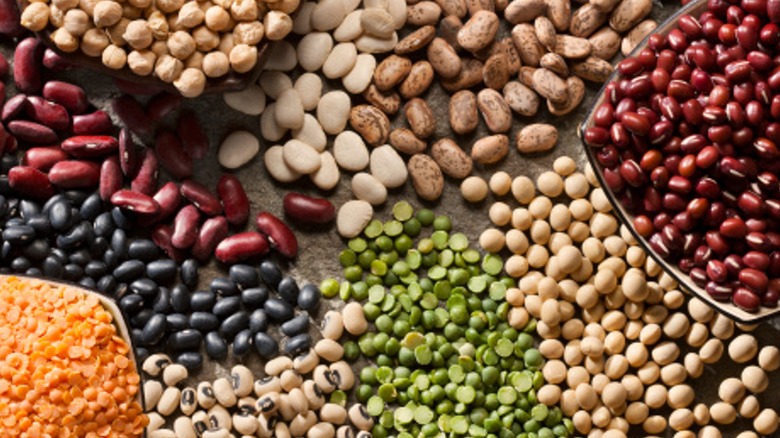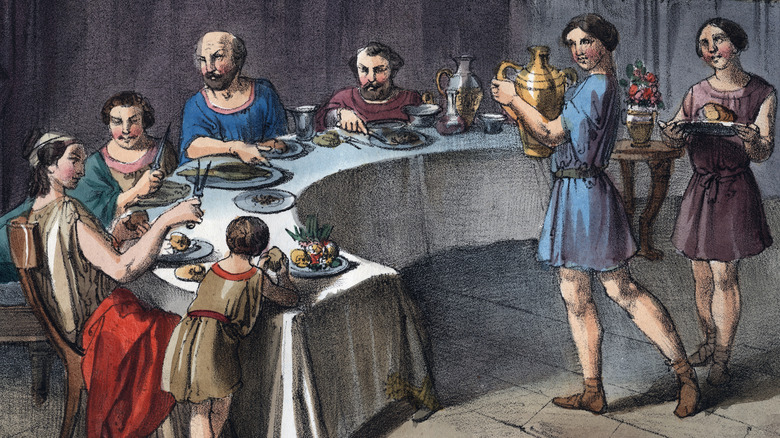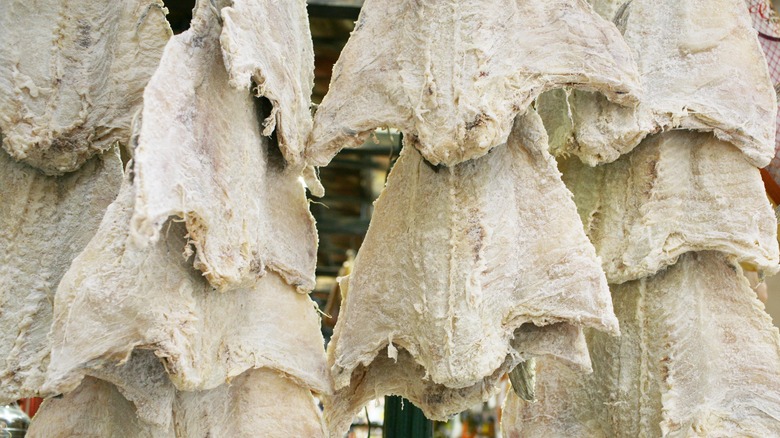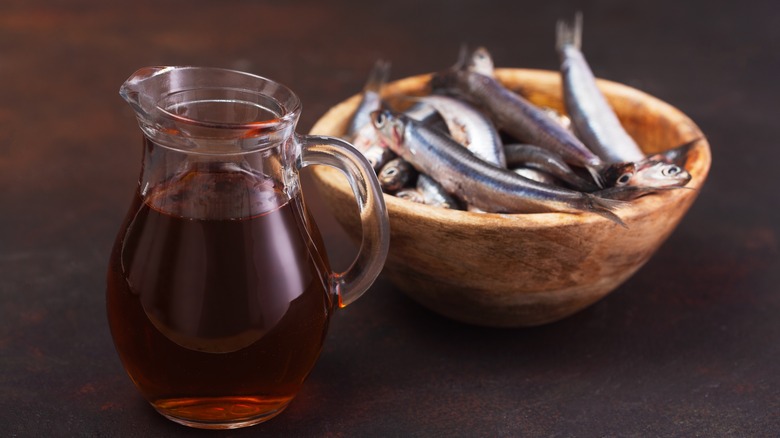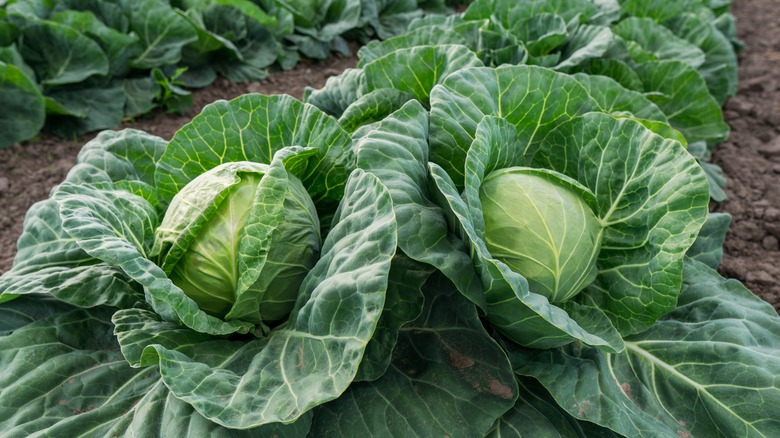Enamored With The Roman Empire? Here's What They Ate
Friends, readers, countrymen (and people): Lend us your ears! Actually, we're probably better served by asking for your eyes rather than ears. Either way, given our determination to begin this article with the staggeringly famous "Julius Caesar" line (from some little-known Elizabethan playwright whom history has forgotten)? It's the best we could do.
Speaking of ancient Rome (and the man who ruled just prior to the Roman Empire's founding), we're sure every male reader has already done their due diligence today and thought about the Roman Empire. After all, the average man doesn't just ponder the Roman Empire on the reg. He thinks about the centuries-long reign of the now-defunct civilization every ... single ... day. At least, that's the scuttlebutt emanating from TikTok in late September 2023.
Even if we aren't entirely sold on the legitimacy of this mental quirk (which all men supposedly share), the recent uptick in discussion about the Roman Empire got us thinking. Namely, what did citizens of that ancient European time period eat on a day-to-day basis? If you're enamored with the Roman Empire — regardless of your gender — keep reading, as we reveal what they ate.
Bread
It's nigh impossible to name a prepared food item with a longer culinary history than bread. Not only is bread a staple food in virtually every civilization around the globe, but it's been a key part of the human diet for tens of thousands of years — a fact that was true even before the start of the Roman Empire in 27 B.C. In that sense, it's hardly surprising that one of the most commonly eaten items by Roman denizens during that time period was a variety of bread products.
Given the prevalence of cereal grains (like wheat) grown within the Roman Empire throughout its existence, bread was an integral part of many Romans' diets. Or, at least, it was for those folks able to afford purchasing loaves from the bakery. In fact, bread may have been out of reach for much of the lower-class populace — leaving those folks to consume other cereal-based food products (one of which we'll address shortly).
For those who were able to enjoy bread, it appears to have been eaten at each and every meal. In fact, since bread was often paired with various cheeses, sliced meats, and wine, you could make the case that both charcuterie and the cocktail party belong on the long list of Roman innovations.
Honey
We've always wondered how honey was discovered. Seriously: Did some random person stumble into a beehive thousands of years ago like the late Thomas J. (Macaulay Culkin) in "My Girl" (he can't see without his glasses!), and a few droplets of that sweet nectar simply splashed onto this unsung hero's tongue? The world may never know. However, we can tell you that honey had begun being cultivated well before the dawn of the Roman Empire — and was often eaten by many Romans during that period as a result.
Now, by and large, honey appears to have been relegated largely to the dessert side of the culinary spectrum within the Roman Empire. It was often used in pancake-type dishes served during that time, and was even used as a glaze of sorts for baked dates. Of course, it wasn't simply used for literal sweets.
The sticky gooey liquid (that may or may not technically be bee vomit) was often added by Romans to enhance various popular sauces. Additionally, honey was a key component in the creation of certain sweeter beverages, including a honey-sweetened wine — an alcoholic drink often served at celebratory dinners known as convivium.
Fresh meat and seafood (if you were wealthy)
Unless you're a student of ancient European history, you may not realize how modern the Roman Empire would have looked to an individual in the 21st century. Of course, even with civil engineering marvels like the stunning-in-hindsight development of a sophisticated sewage system (made possible by Roman aqueducts), the Roman Empire still existed nearly 2,000 years before electricity — or the introduction of long-term refrigeration. On that note, while fresh meat and seafood were indeed eaten by Romans, those foods' tendency to quickly spoil meant only the wealthiest members had consistent access to fresh meat sources.
Even though non-preserved protein sources were generally reserved for the haves of the Roman Empire, that doesn't mean upper-class Romans were feasting on whatever meat they fancied. Since folks were beholden to what was locally and seasonally available, pork and poultry were among the more common types of animal flesh eaten. Certain types of fresh fish were also popular, though it was crucial to serve and ingest the right species — the sort that conveyed a superior social status to their fellow country folk.
Somewhat surprisingly, one of the most popular meals enjoyed by Romans was roasted, stuffed dormouse ... which is exactly what it sounds like. Since we can't say our interest is remotely piqued by the notion of being served baked rodent, perhaps we should thank our lucky stars that certain culinary aspects from the Roman Empire didn't stand the test of time.
Cheese
Aside from pasta and pizza (and cannoli, and tiramisu, and ...), no food may be more emblematic of Roman and Italian cuisine than cheese. From fresh mozzarella to Parmigiano Reggiano, to gorgonzola, to aged pecorino, there are enough Italian varieties to craft a top-notch cheese board. Unsurprisingly, then, that cheese-centric tradition stretches back centuries in the area — and members of the Roman Empire were as enamored with cheese as modern males are with the civilization itself.
Different cheeses were often paired with bread by diners for lunch during the Roman Empire, though that was hardly the only time it was eaten or featured. In fact, baked cheeses were a common menu item offered by Roman Empire-era shops known as thermopolia — or take-and-eat stores that were somewhat akin to fast food restaurants.
Despite its intimate association with the Roman Empire, it's unclear whether cheese was a Roman invention. But even if the first cheesemakers weren't living under Roman rule, it's impossible to deny the dairy food group was an enormous part of that empire's diet.
Figs (and other seasonal fruits)
Like any society that existed before technology allowed for the purchase of every type of produce in virtually every corner of the world (at any time of the year, really), the Roman Empire's fruit and vegetable roster was limited to what was both in-season and local. And of all the fruits commonly cultivated within the Roman Empire's extensive geographical area, none may have been more widely seen and ingested than figs.
It wasn't merely fresh figs that ancient Romans included in their diets during their lives, as dried figs were also popular. More than that, the apparently ubiquitous (and highly nutritious) fruit was key to everyone's dietary intake in the Roman Empire — meaning the poor and wealthy alike were partial to figs.
Beyond figs, there were numerous additional fruits available in the Roman Empire at different times of the year. Apples were commonly eaten, as were dates, pears, and grapes. In fact, grapes were also popular when dried and consumed as raisins — though any fruit amenable to drying was likely consumed in that manner as well.
Eggs
Even though it existed millennia ago, the Roman Empire was far more advanced than many might expect from an ancient society. It counted a number of flourishing urban metropolises within its borders, but a large swath of Romans likely still lived a rural lifestyle. In that regard, it's no surprise many people raised chickens during the period — though the chickens weren't necessarily prioritized for poultry purposes by the average Roman. Rather, the birds were likely used to produce eggs for the population to eat.
Actually, since eggs are essentially a poultry-adjacent food — and were a staple of some well-to-do Roman citizens' dinner menus — not every Roman was apt to regularly find eggs on their plate.
For those who could afford to consume the protein, eggs were actually a top-tier appetizer within the Roman Empire. No matter the preferred preparation, though, it's clear eggs were common for certain Romans (with some surviving for centuries after the empire collapsed).
Legumes
Other than cereal-based food items like bread and puls (hold that thought), no category of food may have been more important to the average Romans' daily diet than legumes. Of course, we're sure the widespread consumption of legumes within the Roman Empire — including beans, lentils, and chickpeas (among others) — wasn't solely out of necessity. Yet at the exact same time, even if a person living in the Roman Empire didn't enjoy legumes, well ... the food seemed nigh impossible to avoid.
Now, by and large, the fact that legumes were plentiful throughout the Roman Empire seems to indicate it was consumed (in some manner, at least) by all members of its society — regardless of one's economic stature. But perhaps the most interesting social group known to have subsisted on a legume-heavy meal plan were the gladiators (the real ones, not Russell Crowe).
Despite the fact that many Roman gladiators volunteered to join the blood sport's ranks (a fairly depressing reality to consider), the ancient athlete's life was usually a grueling slog. And gladiators were often served an actual gruel-type bean soup for their meals — a simple, cheap, and filling option that provided enough nutritional sustenance to ensure the combatants were always ready to battle to the death.
Puls
As we've noted on several occasions already, every denizen living within the Roman Empire likely depended on various types of cereal-based food items for their nutritional intake. Now, while Romans of means were consistently able to take home loaves of bread to eat with breakfast, lunch, and dinner, those folks living on the lower rungs of the economic ladder (who weren't able to bake their own bread, we suppose?) often ate puls — a simple porridge-type dish generally made with boiled grains.
More of a pottage than a porridge, actually, the appeal of puls likely came from its easy preparation process and versatility. After all, it doesn't appear as if cooking puls was dependent on any one ingredient being used. A number of grains, including wheat or spelt, may have been utilized by Roman Empire chefs, and some recipes may have incorporated fava beans (you know they loved their legumes).
To be honest, aside from roasted dormouse, nothing eaten by the Roman Empire may be less appealing to the modern diner than puls. Actually, on second thought? We just might take a literal serving of succulent mouse over the mushy stew.
Salted fish
Like any society that existed before the invention of electricity (and widespread refrigeration), the window to make use of fresh meat and seafood was drastically shorter when the Roman Empire reigned supreme. But just as Caribbean pirates often chose to preserve their protein by drying and salting beef, Roman Empire citizens who wanted (or needed) to lengthen a fresh-caught fish's shelf life would utilize the age-old method as well.
Now, as you might have guessed, not every ancient Roman would be willing to ingest dried and salted fish. In fact, anyone living in the upper echelon of Roman society was immensely unlikely to even consider eating food so far below their station. Still, since many in the Roman Empire weren't members of the socioeconomic elite, they held no such qualms about any supposedly negative signifiers related to salted fish.
If nothing else, we'd like to believe dried and salted fish items weren't always eaten as is, like some sort of fish jerky. And given the prevalence of sauces used by many Romans to enhance their meals, we hope those folks reliant on dried fish for nutritional purposes weren't shy about incorporating said items when munching on dry seafood.
Garum
Of all the foods that we came across during our research of the Roman Empire (and what was eaten by its citizens), none may be less familiar to the modern (or, rather, U.S.-based) palate than garum. Of course, while a sauce made with fermented fish — or, to be more precise, fish guts — may not appeal to many Americans, garum's similar flavor profile to fish sauces popular in Asia actually makes its status as a relic from ancient Rome sort of stunning.
The favorite accompaniment to any meal served in the Roman Empire, garum may be the likeliest food product a time traveler would encounter at a Roman meal. Adding an umami savoriness to everything it was served with (or over), the fermented fish dressing's appeal was substantial.
In fact, given the rather amenable nature of garum to current fish sauces, it's no wonder some modern culinary professionals aren't content to leave the sauce in the past. We can't say whether garum will make a genuine comeback. But if you're thinking of the Roman Empire today (because you're a man, and that's just what happens), and wishing to dine like they did? Find a recipe for garum, and dive right into the fermented funk.
Cabbage and lettuce
It's hardly informative to state people living in the Roman Empire consumed a wide variety of vegetables. You didn't come here to read about broadly generic food groups, after all — you came to discover the specific types of foods preferred within a category. Of course, like fruit, the exact vegetables eaten by ancient Romans were limited to those items both local and seasonal. And while others were found and ingested with regularity, no two vegetables appear to have been as common on Romans' plates as cabbage and lettuce.
Now, the prevalence of lettuce within the Roman Empire might have been relatively easy to ascertain — it's called romaine lettuce, don't you know. But we have to admit we found the extensive consumption of cabbage in ancient Rome to be sort of surprising (though we're not entirely sure we can explain why).
Beyond those two leafy vegetables and common staples, leeks were also widely found throughout the Roman Empire. Additionally, if you were lucky enough to belong to the upper crust, you may find your plate filled with asparagus and mushrooms, too.
Exotic birds
We noted earlier that any type of fresh meat (such as poultry) was generally only available to the richest members of the Roman Empire on a regular basis. But while we assumed their preferred poultry consisted of a variety of chicken breeds, the wealthiest ancient Romans weren't content with those straightforward options. In fact, a number of rather exotic birds were often cooked and eaten in the Roman Empire — including flamingos, parrots, and ostriches.
Now, anyone considering a dish starring, say, the tongue of a flamingo nearly 2,000 years removed from that time period may furrow a brow upon learning of the dish's former popularity. Yet we're not here to judge the culinary preferences of the Roman Empire — we're simply here to report some individuals in the now-defunct society enjoyed the occasional roasted parrot.
So if you're enamored with the Roman Empire in the 21st century — i.e. if you're a living man (we guess?) — and want to live your life like that ancient society? Don't be afraid to add a dish made with cooked peacock or turtledove to your dinner rotation.



